47 Conversion Rate Optimization Statistics That You Need to Know in 2024
Editor’s Note: This post was originally published in October 2021 and was updated in November 2023 for accuracy and comprehensiveness.
Looking to turn more visitors into leads and paying customers?
If yes, staying on top of the latest conversion rate optimization statistics is a must.
Sadly, many CRO stats you’ll find online are either outdated or a little dubious.
That’s why we’ve compiled a list of the most recent and relevant CRO stats from around the web to help you boost conversions throughout 2024. Below, you’ll find stats from across the world of digital marketing, covering SEO, blogging, landing pages, email, and ecommerce.
So, let’s start with some general conversion rate benchmarks.
What’s a Good Conversion Rate in 2024?
What counts as a good conversion rate varies depending on your industry and what marketing channel you’re using. But as a rule of thumb, anything between 2% and 5% is pretty solid.
- Websites: The global average website conversion rate is 3.68%.
- PPC landing pages: The average conversion rate for paid search landing pages across all industries is 2.35%. The top 10% of landing pages have a conversion rate of 11.45% or above.
- Ecommerce: The average ecommerce conversion rate is around 2.03%.
- Blogging: The average blog conversion rate is over 5%.
- Email: The average email click-through rate (CTR) is 8.93% across industries.
SEO Conversion Rate Statistics
Here’s a list of the latest SEO conversion rate stats:
1. The top organic results on Google average a 45.61% CTR
Getting your website to rank at the top of Google’s results pages through effective SEO strategies means you’ll enjoy the highest CTR possible.
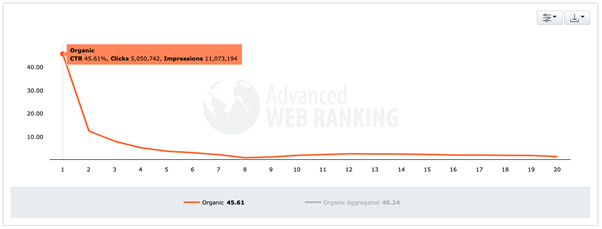
2. Title tags with 40 to 60 characters have an 8.9% higher CTR
Shorter to medium title tags generally perform better than longer ones. Always remember to include your main keyword in your title tag to make sure that it’s optimized for search.
3. 46% of all Google searches are for local information
Optimizing for local searches is a great idea if your business offers local products or services.
You can work on your local SEO by creating a Google Business Profile, targeting local keywords, and creating content with local relevance.
4. Local searches account for 22.6% of online traffic
Since searches with local intent make up a huge proportion of all web traffic, you’re leaving a ton of visits on the table if you don’t have a local SEO strategy in place.
5. Mobile devices account for more than half of organic traffic
In the U.S., mobile devices account for roughly 63% of organic search visits.
Your website must be responsive to provide a good user experience on all devices.
6. The first result on Google has 3.8 times more backlinks than positions 2 to 10
The more backlinks you receive from relevant and authoritative sites, the more likely you’ll rank prominently in Google’s search results.
7. Most top-ranking pages are around three years old
The sooner you invest in an SEO program, the sooner you can start reaping the rewards of better rankings.
8. 50% of the U.S. population uses voice search each day
If you haven’t yet, you need to optimize your website for voice search.
You can do this through several methods, like targeting conversational keywords, creating FAQ content, and optimizing your local search.
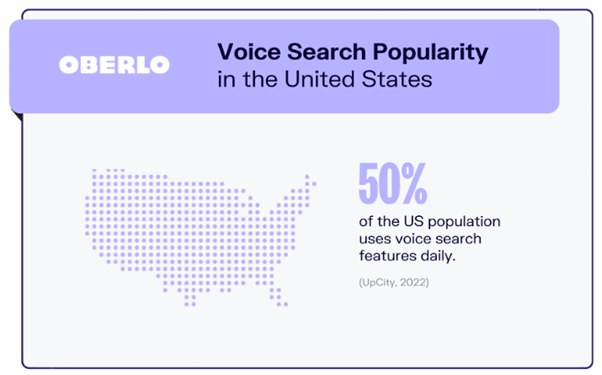
SEO Conversion Rate Referenced Sources:
Landing Page Conversion Statistics
Here’s an up-to-date list of landing page conversion rate optimization stats.
1. Businesses with over 40 landing pages generate 12 times more leads than those with 1 to 5 landing pages
Creating dedicated landing pages for each of your offers can multiply the amount of leads you generate. This is because more landing pages mean more opportunities to address the preferences and needs of specific audience segments.
2. Removing the navigation bar from your landing page can double your conversions
VWO used an A/B test in which they removed the navigation bar from Yuppiechef’s landing page. It resulted in signups going up from 3% to 6% — effectively doubling their conversion rate.
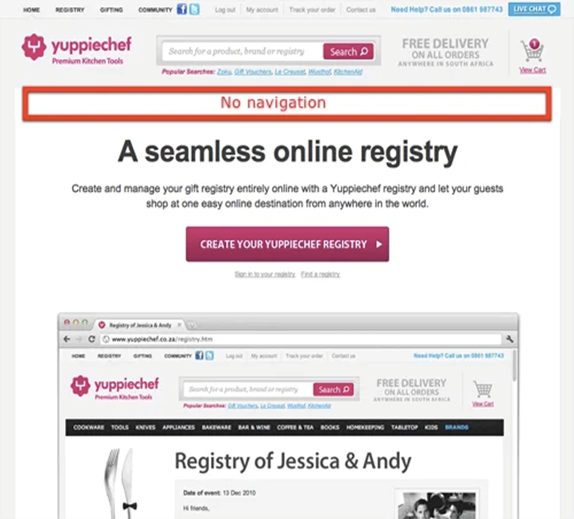
3. Personalized calls-to-action (CTAs) convert 202% better
Personalized CTAs (also called “smart” CTAs) dynamically change based on user data, delivering a more tailored user experience than generic prompts.
4. 38% of marketers say having a video on a landing page positively impacts conversion
Videos are especially good at showcasing products and explaining concepts in more dynamic and engaging ways than text.
5. Increasing page load speed from 5 to 1 second can triple your conversions
Page speed is a crucial aspect of user experience. The longer your page takes to load, the more likely users will bounce.
6. Most landing pages have five form fields
Users shouldn’t feel like you’re overloading them with questions. You can minimize friction and maximize conversions by limiting your form fields as much as possible.
7. Adding a floating coupon to your landing page can increase your click-through rate by 12%
A test done by Jeff Rizzo from Slumber Yard showed that the company’s click-through rate increased by 12% when they added a floating coupon to landing pages.
These coupons can be small perks, such as free shipping.
8. 60% of companies perform landing page A/B tests
There’s no better way to continually improve landing page conversion rates than to conduct regular split tests to see which content variations work best.
Landing Page Conversion Rate Referenced Sources:
Ecommerce Conversion Rate Statistics
Having a solid ecommerce SEO strategy in place is crucial. Here are the top ecommerce conversion stats.
1. The average ecommerce conversion rate is 3% on desktops and tablets and 2% on smartphones
While shoppers browse and research products on the go, they prefer to complete the checkout process on their computers. You can improve your mobile ecommerce conversion rates by simplifying the smartphone checkout experience.
2. Ecommerce conversion rates drop by 0.3% with every extra second it takes a page to load
Once again, ensuring your pages load quickly is key to maximizing conversions. Check out Google’s PageSpeed Insights for advice on how to optimize your page speed.
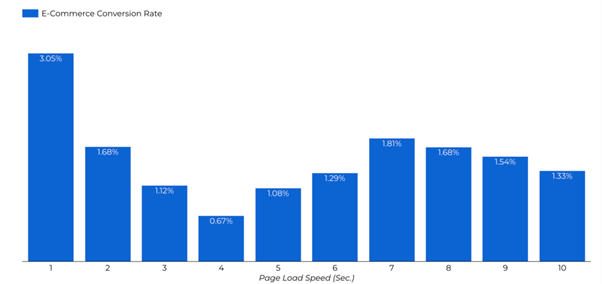
3. 51% of shoppers use Google to research products they plan to buy online
Effective ecommerce SEO is essential for online retailers to enhance visibility, attract potential customers, and stay competitive in the digital marketplace.
4. The second biggest reason for online cart abandonment is having to create an account to check out
You can increase conversions by allowing shoppers to complete their purchases via guest checkout. This is especially appealing to one-time buyers and those reluctant to share their personal information.
5. 86% of millennials are digital buyers compared with just 62% of baby boomers
Your target audience’s age profile influences their online buying behaviors. While younger shoppers are digital natives, older consumers have varying levels of tech-savviness. This is another essential reason for creating a clear and intuitive online shopping experience.
6. The average ecommerce cart abandonment rate is 69.57%
You can minimize cart abandonment by being transparent about costs such as shipping, streamlining the checkout process, and implementing cart abandonment recovery strategies like follow-up emails.
7. 50% of shoppers say that images help them decide what to buy
Investing in high-quality, detailed product images improves the customer experience and helps them with decision-making.
8. The arts and crafts industry has the highest average conversion rate at 3.84% – 4.07%
It’s important to note that even though the average ecommerce conversion rate is 2.03%, conversion rates vary significantly from one industry to the next.
9. 59% of online shoppers say that it’s important for them to be able to shop on mobile when deciding which brand to buy from
In other words, your ecommerce store should offer a mobile-friendly user experience to attract and convert as many customers as possible.
10. Mobile now accounts for 60% of global ecommerce sales
This is yet another reminder of why prioritizing the mobile experience is vital for online retailers.
Ecommerce Conversion Rate Referenced Sources:
Blogging Conversion Rate Statistics
Creating high-quality blog content is a great way to increase your search visibility, educate readers about your products, and, ultimately, generate more leads.
Here are some of the latest blog conversion statistics.
1. Articles of 3,000 words or more get twice the amount of page views, as well as 24% more shares
As a rule, readers tend to get more value from longer posts and spend more time reading them. As a result, Google often ranks longer posts higher since they’re perceived as more engaging and authoritative.
2. 57% of marketers have increased sales directly through blogging
Developing a well-planned, consistent blogging strategy can be a key component of boosting overall sales.
3. The average blog visit-to-lead conversion rate is 1% to 3%
Consistently producing high-quality blog content is an effective strategy for attracting qualified visitors and converting a significant portion into leads.
4. Small blogs should post three to four blog posts per week, whereas large blogs should post four to five blog posts per week
Maintaining a regular blog posting schedule is essential for maximizing organic search visibility. The bigger your blog, the more frequently you should post new content.
5. Content marketing costs 62% less than traditional marketing methods, yet it generates three times more leads
Investing more resources into your content marketing program is a path to more leads and conversions, not just increased brand awareness.
6. The average time on page for blog posts is 2 to 5 minutes
The more time users spend reading your blog, the more likely they are to find value in it. You may need to review your content quality if readers leave before the two-minute mark.
7. One compounding blog post produces as much traffic as six decaying posts
Compounding posts see a progressive increase in organic traffic over time. On the other hand, decaying posts see an initial spike in traffic after publication but steadily lose traffic over time.
8. Blog posts that contain at least one list per every 500 words get 70% more traffic
Structuring information in a list format can significantly enhance reader engagement, thanks to the clarity, readability, and ease of consumption lists provide.
9. Bottom-of-funnel posts convert up to 2,400% more than top-of-funnel posts
If you want to focus on using blogs to drive conversions (instead of prioritizing awareness and traffic), build your posts around high purchase-intent keywords.
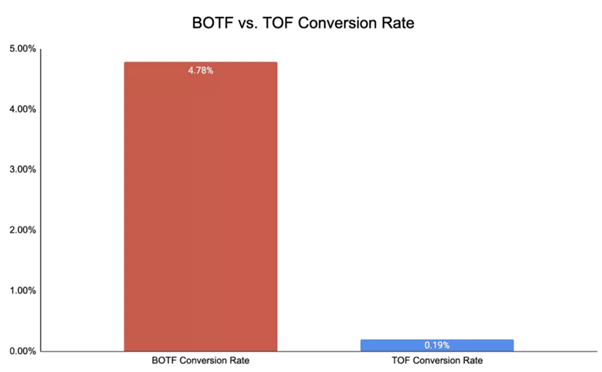
Blogging Conversion Rate Referenced Sources:
Email Conversion Rate Statistics
Around 4.48 billion people use email globally. No other channel comes close to this level of reach.
Here are some of the most recent email conversion rate optimization stats.
1. On average, businesses generate $36 for every $1 spent on email marketing
Email marketing remains one of the most effective and profitable forms of digital marketing.
By investing in email marketing, you’ll be able to continuously distribute content and offers to your subscribers—increasing your overall sales significantly.
2. 64% of small businesses reach customers with email marketing
Email marketing works just as well for small businesses as big ones. The channel offers personalized communication and long-term relationship-building with customers at a relatively low cost.
3. Using a CTA button instead of a text link in your email can increase your CTR by 28%
By replacing your CTA text link with a button, your email won’t just look more appealing; it will also get more readers to click through to your offer/landing page.
4. 81% of users prefer open emails on their mobile phones
Remember that only the first 30 to 40 characters of your subject lines are visible on mobile.
So, keeping your subject line short and sweet will optimize it for mobile, which could increase your email open rate.
4. Personalized emails generate an average ROI of 122%
There are several ways in which you can personalize your business emails. For example, you can segment your email lists according to locations, interests, or customer journey stages and add your recipient’s name to the subject line.
5. Increasing your email CTR by 0.5% can result in a 25% growth in sales revenue
Increasing your email CTR can have a massive impact on your sales revenue. Some of the most effective ways to increase click-throughs include crafting compelling subject lines, segmenting your audience for targeted content, and using persuasive CTAs.
6. Email click-through rates are the highest at 6 am and 6 pm
Scheduling your emails outside regular working hours means more recipients will be free to open and act upon your campaign.
7. Birthday emails generate 481% more sales than general marketing emails
Sending personalized emails to your subscribers on their birthdays is a simple way to make a great impression and boost sales.
Email Conversion Rate Referenced Sources:
